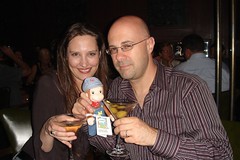A couple of years ago, when Julian Cole kicked off his Top 50 blog list, ranking “Australian pioneer marketing blogs”, it caused something of a sensation. Some people loved it. Some people hated it. Many could care less. And that’s the way it is with social media – there’s plenty of interesting content to consume, so if you don’t like one blog, or social media channel, you can simply surf across to another.
But for those of us who ARE interested in Australian marketing blogs, this list has become something of an institution. Here is Julian’s updated list for 2010. It’s good to see some new entrants – I will certainly be checking out a few of these.
| Blog Name | Pioneer Score | Google Reader | Alexa Score | Total | |
| 1 | Digital Buzz Blog | 9 | 7 | 9 | 25 |
| 2 | Mumbrella | 9 | 5 | 9 | 23 |
| 3 | Bannerblog | 7 | 7 | 9 | 23 |
| 4 | The Inspiration Room | 7 | 6 | 9 | 22 |
| 5 | Campaign Brief | 7.5 | 5 | 9 | 21.5 |
| 6 | Marketing Magazine | 8 | 4 | 8 | 20 |
| 7 | Servant of Chaos | 9 | 4 | 7 | 20 |
| 8 | B&T | 6.5 | 4 | 9 | 19.5 |
| 9 | Laurel Papworth | 7 | 4 | 8 | 19 |
| 10 | Young PR | 8 | 3 | 8 | 19 |
| 11 | Personalize Media | 7.5 | 3 | 8 | 18.5 |
| 12 | Adspace-Pioneers | 8 | 4 | 6 | 18 |
| 13 | Better Communication Results | 7 | 5 | 6 | 18 |
| 14 | Media Hunter | 8 | 3 | 7 | 18 |
| 15 | Amnesia Blog | 5.5 | 5 | 7 | 17.5 |
| 16 | Life. Then Strategy | 8 | 3 | 6 | 17.5 |
| 17 | Online Marketing Banter | 8 | 3 | 6 | 17 |
| 18 | acidlabs | 8 | 3 | 6 | 17 |
| 19 | Talking Digital | 8 | 3 | 6 | 17 |
| 20 | Consumer Psychologist | 8 | 4 | 5 | 17 |
| 21 | Brand DNA | 8 | 4 | 5 | 17 |
| 22 | Digital-Media | 8 | 1 | 8 | 17 |
| 23 | Get Shouty | 8.5 | 3 | 5 | 16.5 |
| 24 | Gold Coast Web Designers | 6 | 3 | 7 | 16 |
| 25 | Shifted Pixels | 7 | 2 | 7 | 16 |
| 26 | A perspective | 8 | 2 | 6 | 16 |
| 27 | Angus Whines | 7 | 3 | 6 | 16 |
| 28 | Dan Pankraz | 8 | 3 | 5 | 16 |
| 29 | WayCoolJnr | 8 | 3 | 5 | 16 |
| 30 | AdNews | 8 | 0 | 8 | 16 |
| 31 | Publicis Digital | 7.5 | 3 | 5 | 15.5 |
| 32 | Gourmet Ads | 7 | 1 | 7 | 15 |
| 33 | PR Warrior | 8 | 2 | 5 | 15 |
| 34 | FRANKthoughts | 8 | 2 | 5 | 15 |
| 35 | PR Disasters | 7 | 3 | 5 | 15 |
| 36 | Matthew Gain | 8 | 1 | 6 | 15 |
| 37 | Zakazukhazoo | 6.5 | 1 | 7 | 14.5 |
| 38 | EcioLab | 7.5 | 2 | 5 | 14.5 |
| 39 | Corporate Engagement | 6.5 | 3 | 5 | 14.5 |
| 40 | Dominique Hind Collective | 7 | 2 | 5 | 14 |
| 41 | Tim Longhurst | 6.5 | 2 | 5 | 13.5 |
| 42 | Pigs Don’t Fly | 7.5 | 2 | 4 | 13.5 |
| 43 | The Flasher | 8.5 | 1 | 4 | 13.5 |
| 44 | Three Billion | 6 | 1 | 6 | 13 |
| 45 | Marketing Easy | 6 | 1 | 6 | 13 |
| 46 | Who is in conrtol of your b**** | 8 | 1 | 4 | 13 |
| 47 | Sticky Ads | 6.5 | 0 | 6 | 12.5 |
| 48 | Mark Neely's Blog | 7.5 | 1 | 4 | 12.5 |
| 49 | Business of Marketing and Branding | 6.5 | 2 | 4 | 12.5 |
| 50 | CIIMS | 7 | 1 | 4 | 12 |
